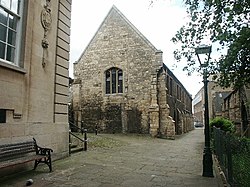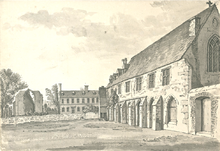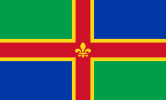| The Greyfriars, Lincoln | |
|---|---|
 The Greyfriars, Lincoln The Greyfriars, Lincoln | |
| Location | Lincolnshire |
| Coordinates | 53°13′45″N 0°32′13″W / 53.2293°N 0.5370°W / 53.2293; -0.5370 |
| OS grid reference | SK9775971248 |
| Founded | c1230 |
| Built | 13th century, with mid-19th-century additions. |
| Restored | 1906 |
| Architect | William Watkins |
| Architectural style(s) | Early English architecture |
| Listed Building – Grade I | |
| Designated | 8 October 1953 |
| Reference no. | 485917 |
 | |
The Greyfriars, Lincoln was a Franciscan friary in Lincolnshire, England. The surviving building is the remains of the infirmary of the friary, built of dressed stone and brick and dating from c.1230, with mid-19th-century additions. The clay tile roof of the main building is in a poor condition and the Welsh slate roof of the 19th-century extension has been repaired.
History
Franciscan Friary
Building of the Friary was started in 1237 on land donated to the Franciscan order and was completed by the 1280s. The community was expelled in 1538 as part of the Dissolution of the Monasteries.
Burials in the friary
- Lady Alice de Roos (daughter of William de Ros of Helmsley), wife of John Comyn I of Badenoch
Grammar School and Mechanics' Institute
See also: Lincoln Grammar School See also: Lincoln Mechanics' Institute
The building was let to William Monson, whose son Richard opened a school there in 1568. From 1574 the school became the Corporation Grammar School run by Lincoln City Council on the upper floor until 1900. The undercroft was successively used as a spinning school which became known as the Jersey School until 1831, a Mechanics' Institute from 1833 to 1862 and as part of the Grammar School from 1862 to 1899. George Boole participated in the Mechanics' Institute.
City and County Museum

Under Lincoln City Council
In 1900 the building ceased to be used as a school. It was restored under the supervision of Lincoln architect William Watkins. It was opened to the public as the City and County Museum on 22 May 1907. The Museum was administered by the City of Lincoln and the first Curator was Arthur Smith who retired in 1934 and was followed by F. T. (Tom) Baker, who was the son of the Lincoln architect Fred Baker.
Lincolnshire County Council
In 1974 control of the Museum passed to Lincolnshire County Council. In September 1993 the museum's use of Greyfriars changed with the building becoming a venue for annually changing exhibitions while its main collections underwent a programme of conservation and research in expectation of a new home being built. In 2005, The Collection opened on a new site on Danesgate, adjacent to the Usher Gallery, with the two being jointly managed as a cultural centre for art and archaeology.
After closure the building was used for a period by the Central Library, but from 2008 has been left vacant, apart from occasional use for contemporary art exhibitions and installations. In 2016 the city council considered selling the building.
A project, funded by £3m from organisations including the National Lottery Heritage Fund, will bring Greyfriars back into use. It is on Historic England's Heritage at Risk Register but it could reopen in 2025 as a venue for weddings, conferences and education, run by Heritage Lincolnshire.
Literature
- Antram N (revised), Pevsner N & Harris J, (1989), The Buildings of England: Lincolnshire, Yale University Press. pp 508–9.
- Baker F.T. (1985) A Lifetime with Lincolnshire Archaeology Journal for Lincolnshire and Archaeology, Vol 20 and re-printed by the Society. ISBN 0904680541.
- Hayfield C (2006). Conservation Plan for the Greyfriars Building, Lincoln. Report for the City of Lincoln Council.
- Lee A (2019), The man who made the Museum: Arthur Smith and the founding of the Lincoln's City and County Museum. Part Two - the development of the Museum. Lincolnshire Past & Present, No. 115, Spring 2019, pp. 13–17.
- Little A G (1906), Grey Friars of Lincoln in Victoria County History of the County of Lincoln, Vol II (ed. W. Page) pp. 222–4.
- Leach A.F. (1906), Schools-Lincoln Grammar School in Victoria County History of the County of Lincoln, Vol II (ed. W. Page) 421-443
- Martin A R (1935), "The Greyfriars of Lincoln", Archaeological Journal Vol 92, pg 42–63.
- Moore C. N. (1972), City and County Museum, Lincoln. 24pp
- Padley J.S., (1851) Selections from the Ancient Monastic Ecclesiastical and Domestic edifices of Lincolnshire, Lincoln.
- Simpson E. Mansel (1903) The Grey Friary, Lincoln Lincolnshire Notes and Queries, pp193–202.
- Stocker D.A. (1984), The remains of the Franciscan friary in Lincoln, York Archaeological Papers, York Archaeological Trust, 135–137.
- Watkins W & Son (1903) Report on the Proposed Conversion of the building known as "The Greyfriars" to the purposes of a Museum, with a brief account of the Archaeological History of the Structure Lincoln Corporation.7pp.
References
- "Greyfriars' Museum, Lincoln". British Listed Buildings. Retrieved 11 February 2014.
- ^ "Greyfriars former monastic building, Broadgate - Lincoln". historicengland.org.uk. Historic England.
- ^ "The Greyfriars". Lincoln City Council. Retrieved 12 February 2014.
- Francis Hill (1974), Victorian Lincoln; p.149
- Society for the History of Astronomy, Lincolnshire.
- Lincolnshire Echo - Tuesday 23 May 1911
- "Baker (1985), pg 10
- "History of the museum on The Collection website". Archived from the original on 25 February 2014. Retrieved 3 January 2020.
- "Former museum to be sold". City of Lincoln Council. Lincoln City Council. Retrieved 8 January 2017.
- "Restoration work begins on 'at-risk' building". BBC News. 19 September 2024. Retrieved 19 September 2024.
External links
 Media related to Greyfriars, Lincoln at Wikimedia Commons
Media related to Greyfriars, Lincoln at Wikimedia Commons- British Listed Buildings

